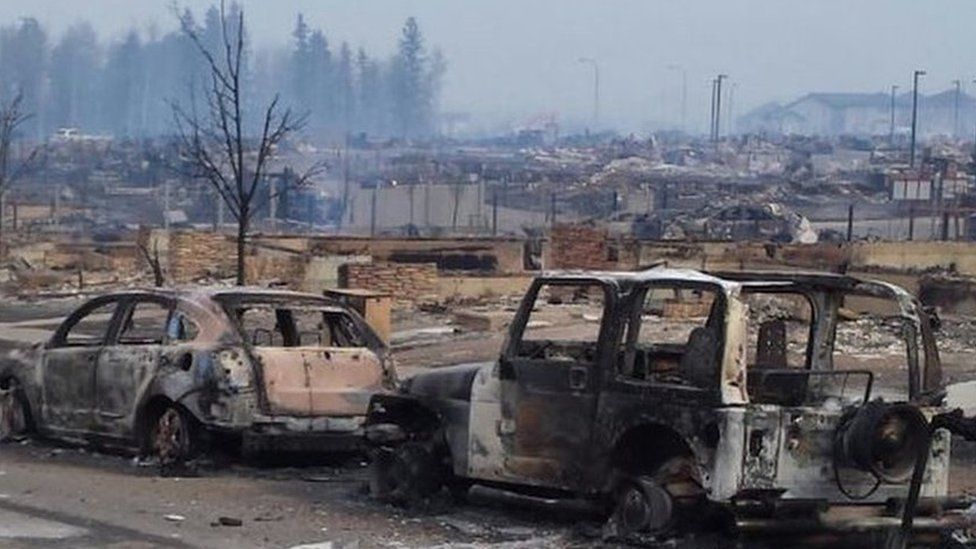Canada wildfire: Images show Fort McMurray devastation
- Published

Pictures obtained by the BBC show large parts of the Canadian city of Fort McMurray in ruins following a devastating wildfire.
The exact scale of the damage is difficult to assess, as access to the city is restricted.
Officials have given few details other than to report that 1,600 homes and other buildings have been destroyed.
However, people who have seen the damage say whole neighbourhoods have been wiped out.
One picture shows the ruins of many houses, with a car untouched by fire. In another, a destroyed church is surrounded by rubble.
Some parts of the city, in the province of Alberta, have been defended resolutely and are still standing.
The city's airport suffered only minor damage despite being licked by flame and engulfed by smoke.
Only the "Herculean" efforts of fire fighters saved the facility, says Scott Long of the Alberta Emergency Management Agency.
Keith Doyle reports that people are hoping for rain
Crews also managed to protect other key infrastructure including the water treatment plant and the hospital.
Many homeowners were not so lucky.
The images of whole neighbourhoods in ruins are shocking but they will not surprise the people of Fort McMurray who fled knowing that their city was in danger of being consumed by fire.
The fire in the province of Alberta covers 850 sq km (328.2 sq miles), and the entire city of almost 90,000 people was evacuated three days ago.
Most fled south but some of those who headed north have been airlifted to safety.
A police-escorted convoy of 1,500 vehicles was passing through the city along the only safe route to Edmonton and Calgary to the south, but police have told the BBC it has has been suspended because of flames up to 200 feet high on both sides of the road.
It will take approximately four days for the Royal Canadian Mounted Police to escort all evacuees from sites north of Fort McMurray, authorities said.
For nearby communities though the danger has not receded.
Officials are predicting that it will be "weeks and weeks" before the fire is completely out. The region has not had significant rain in two months.
The skies above the empty and smouldering city are full of strange shapes.
There are clouds that billow like bright white cauliflowers, boiling rapidly as they change by the second.
There are clouds illuminated by vertical streaks of a dull red from the fires on the ground.
And there are giant clouds stretching as far as the eye can take in with a single glance, great walls of smoke blown sideways by the strong winds.
The helicopters - almost 150 of them, we are told - look puny in the face of such a dramatic display of nature's power, but occasionally they do seem to be making progress in slowing the fire's march across the plains.
Ultimately though, says Bill Stewart, co-director of the University of California's Center for Fire Research and Outreach, only nature can stop it entirely.
Canada fires: Amateur footage shows resident's terror
"You could add five times the number of firefighters," he said, "but you can't get all the embers. There's no way to put out every ember flying over firefighters' heads."
That makes for a terrifying and dangerous time for those on the front line of the fight.
On Thursday night we watched as firefighters rushed into the community of Anzac, trying to save it from flames which were tearing through a forest on the shores of nearby Gregoire Lake.
From across the lake the sight was stunning and horrifying. Fierce winds fanned the flames, and towering conifer trees went up in a flash as if they were matches struck on a box.
The whole blaze sent a pall of smoke high above, while the fires gave the sky an orange glow which could be seen for miles around.
It felt like a distress signal, signifying a disaster which is still unfolding.
Syrian refugees escape from Fort McMurray fire
Some Syrian refugees escaped violence in their home country only to have to flee their new homes in Fort McMurray. The Globe and Mail reported on the Labak family, who had fled Syria in 2011 and arrived in Canada two months ago, settling into Fort McMurray.
"My kids, mom say, 'What [do] we have to do? You said to us we will live there, we will live happy. Why that happened to us?'" Ms Labak told the newspaper. "That's very bad. I can't answer to them anything."
The fire, ash and smell in the air as they fled the town were reminiscent of bombings at their home in Damascus. They told the Globe and Mail that the cots at the shelter near Fort McMurray reminded them of refugee camps. They left most of their belongings - including their passports - behind.
In Calgary, some Syrian refugees are organising a support group for victims of the fire on Facebook, the Calgary Herald reports.
"(Canadians) gave us everything. And now it's time to return the favour," Rita Khanchet, who came to Calgary from Syria five months ago, wrote in the group.
Money being collected by the group will go toward hygiene items for Fort McMurray evacuees.

